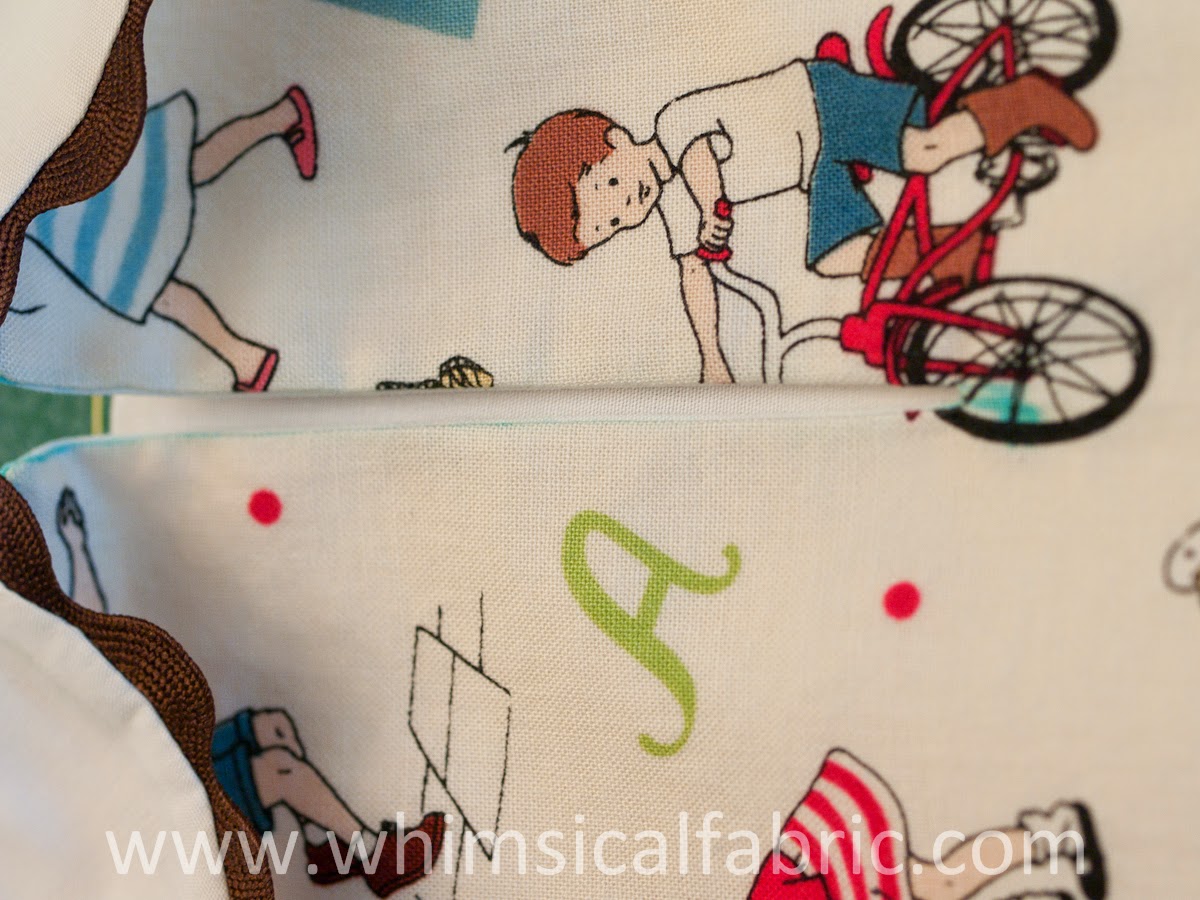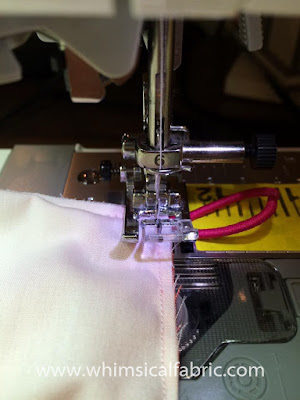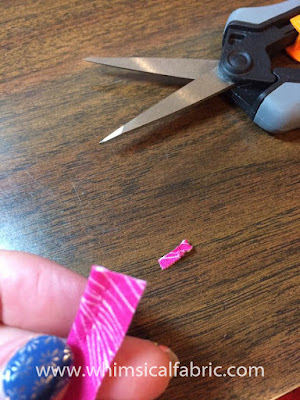** If you would like to see an image on our blog in a larger format, just click on it to enlarge.
Note: Links to products within this post are either links to our website or affiliate links.
Please read the directions in your Frannie Dress pattern all the way through before you begin. It's probably a good idea to read through this lesson once before you begin also.
Day 2 -Stitching the Neck Opening, Adding Piping, Stitching the Armholes, and Side Seams.
1. If you washed the Wonder Tape or glue off your collars they should be dry by now. Grab your collars and give them a good pressing. Be careful though because ric-rac will melt with too hot of an iron.
Or, if you added piping you should be ready to go.
2. Lay your dress out like so.
3. With the top side up and the front edge of the collar (edge with the pin) lined up on the center front of your dress, match up raw edges of your collar and dress. Pin into place.
4. Repeat for the other collar.
5. Using a long stitch length, baste the collars onto the dress. I find it easiest to baste about ⅛" from the edge. Excuse my crazy stitches below. A little girl distracted me. ;)
6. With right sides together, lay your lining on top of your dress, sandwiching the collar in between. Match up shoulder seams, center front, center back, and pin together.
7. Using a ¼" seam allowance stitch the dress, collar, and lining together around the neck opening. When you arrive at the center back, with your needle down, stop at the line you drew for the back slit. Raise your presser foot and pivot your fabric 45º. Using your hand wheel, stitch one stitch ACROSS the corner. Pivot another 45º so you are now heading down the angled line you drew for the back slit. I always like to do one stitch ACROSS corners because it make the corner turn sharper and look better.
At this point it is a very good idea to decrease your stitch length. We will be cutting the fabric very close to the stitches and decreasing your stitch length will help keep your fabric from pulling out. I decreased mine from 2.5 down to 1.
Now, stitch slowly and very carefully along the line you drew.
8. When you are one stitch away from the bottom of the V stop with your needle down. Pivot 90º. Using your hand wheel, stitch one stitch ACROSS the bottom of the V. Again with your needle down, pivot and head up the other side of the V. When you reach the neck go ahead and increase your stitch length, stitch one stitch across the corner, and continue sewing around the neck opening.
9. Trim your seam.
10. Now for the scary part! No, it's not really scary. Well, just kinda. Take a pair of sharp shears. Make sure they are ones that you have very good control over. Carefully cut down the center slit. Cut all the way to the bottom stitch, being very careful not to cut any stitches. The closer you get to the bottom stitch the cleaner your facing will look when you turn it. But DO NOT clip any stitches or it will be a mess. Make sure you have good lighting and you can see what you are doing well. Go slowly.
11. Turn your dress right side out. Press out the corners at the top of your back slit. To get a good clean look to your back slit you will need to carefully tug down on your lining fabric at the base of the slit. Iron the corners and the slit well.
Your back slit should look like this when you are done. If you don't have a distinct V you might need to clip closer to that bottom stitch. Just don't clip it.
12. If you will be adding a label to the inside of your dress now would be a good time to add it. I pull my dress fabric away and sew it just to the inside of the lining. BTW, Wonder Tape is great to keep labels from shifting while you stitch. ;)
13. This is also the time to add your elastic loop for your back button. This part is optional. At the end of this lesson we do teach how to make a button loop with thread, so if you prefer that method go ahead and skip down to step #17.
Lay out the dress with the backside facing you. We are going to carefully tear out just a couple of stitches on the back opening. You want your elastic loop to be on the wearers left. Turn your dress inside out and very carefully rip out a few stitches, just enough so you can poke the hair tie between the lining and dress fabric, like so. Make sure the end with the glue joint is sticking out. That's a weak spot so we don't want to use it.
14. Stitch back and forth a few times right over the original stitch lines securing the elastic in place. Cut off the excess elastic (but not too close).
15. When you turn your dress right side out it should look something like this.
16. Go ahead and add your button on the other side, pulling your lining away so your stitches do not show on the inside of the dress. You might want to add a little piece of fusible interfacing behind your button and before you begin stitching to give your fabric and button a bit more stability.
17. If you will be adding piping to your armscye now is the time. First though we want to trim the cording out of the what will be the seams. This allows the seams to lay flat when we sew them. Grab your piping and clip the end of nice and straight.
18. Next, open up your piping to expose the cording.
 |
| Ignore my horrible looking nails. My manicure was over 2 weeks old here. |
20. Just as we did for the collar, lay your piping with raw edges lined up on top of the armscye of your dress fabric.
21. Baste the piping onto the dress using a piping/zipper foot.Don't forget to trim the cording out of the seam allowance on the other end of the piping now.
22. Lay out your dress like this again.
23. Grab the right edge of the dress fabric and pull it over the dress front and collar, towards the left side. Reach under the dress and grab the right edge of the lining and pull it under the dress and collar towards the left side.
24. Matching up shoulder seams, pin the dress armhole edge to the lining armhole edge right sides together.
25. When pinning you want to slide the lining so that it is poking out an ⅛" from the dress. You might remember that we did this with the Exchange Dress. If you are not using piping or trim on the seams this will ensure that the lining does not show when turned. NOTE: If you are using piping don't slide the lining out. Just make sure the raw edges are lined up with the piping sandwiched in between.
26. Keep pinning the entire armhole. You will need to tuck the collar/neck opening and left armhole fabric in between what you are pinning. Just scrunch it up good and pin away.
27. Using a ¼" seam allowance stitch the armhole edges. Trim your seam allowance and clip your curves. If you added piping to the seams here you will need to stitch with a piping/zipper foot. Increase the presser foot pressure and go slow.
28. After sewing your armhole seams your dress will be all bunched up between the armhole and the neck opening.
29. To turn your dress you will need to reach between the dress and lining and start pulling the dress through the shoulder area.
Keep pulling and pulling until you pull the dress free.
30. Repeat for the other armhole.
If you are still not sure how to sew these armholes you might want to take a peek at the Children's Corner video tutorial. It can be a great help!
31. Press the armholes seams well. If you had your lining poking slightly out past your dress material when you stitched, you will see how the dress material is ever so slightly pulled to the inside of the dress. This ensures that the lining will not show when the dress is worn.
32. Lay out your dress again.
33. Grab your dress front and back and lift up and over the dress, exposing the lining below.
34. With the right sides together and dress fabric matched up with dress fabric, lining fabric matched up with lining fabric, and the underarm seams lined up, pin together both sides of dress and lining. Note: With piping, you want the piping to be laying towards the lining This helps it stick up above the main dress once its turned right side out.
35. Stitch side seams together using a ¼" seam allowance. Don't forget to leave a 5-6" opening in one of your side seams!
That's it. You are all done for today. Congratulations! Check back here tomorrow for lesson three.
* If you would like to enter the prize drawing, please make sure you submit a picture of your completed lesson two to the Facebook Album by 12:00 noon CT, Tuesday, May 10th. Also, if you have any questions the Facebook Group is a great place to ask.
Thanks for sewing with me,
Danielle Storm






































No comments:
Post a Comment